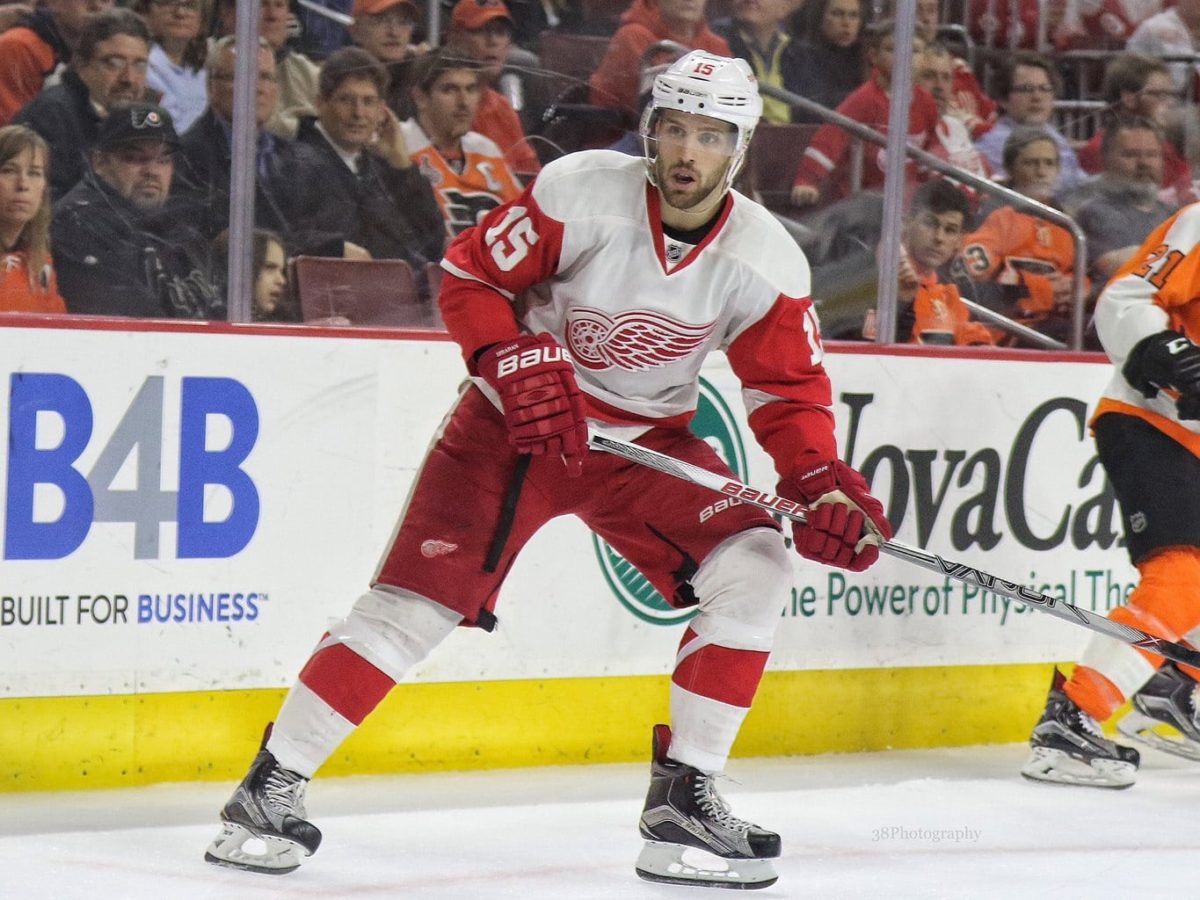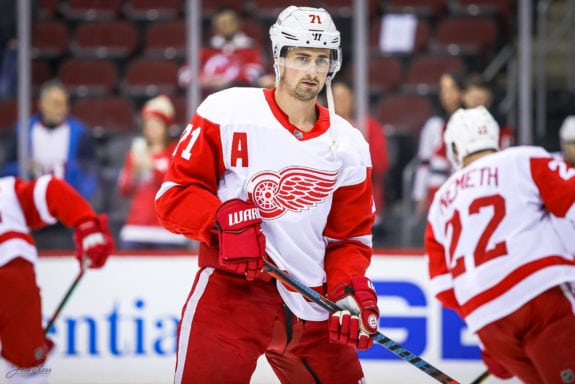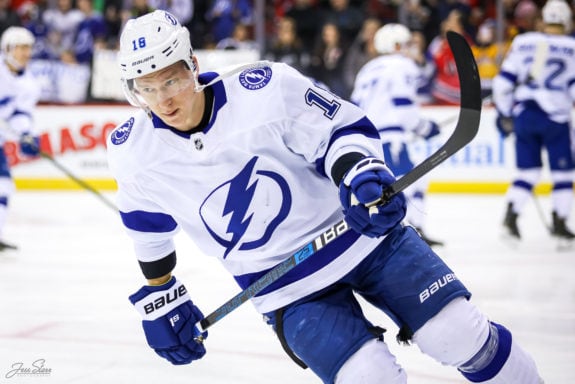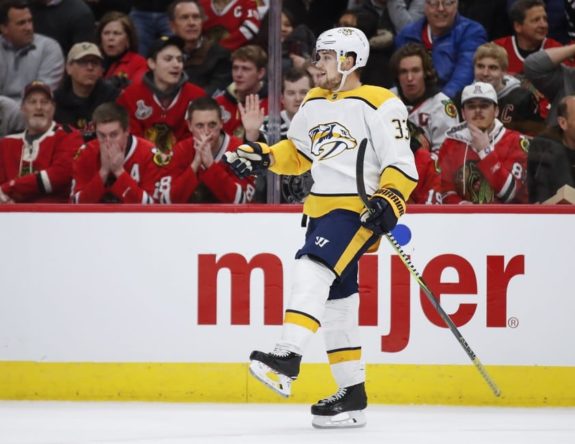Drafting is an imperfect science. There are rules you can identify and behaviors you can pinpoint in order to get a good idea of what a player might become, but at the end of the day, it’s all a theory until proven to be factual. This is why even the best scouting departments are going to miss on their fair share of players.
Earlier this month, we identified some of the Detroit Red Wings’ biggest misses on the draft floor from the year 2000 to 2009. Today, we’re looking at the first half of the 2010’s – from 2010 to 2015. Players drafted during this time period have had at least five years to start their NHL careers and realize the potential they showed during their draft year. When it comes to prospects, you should never rush to judgment – that’s why we’ll leave the latter half of the decade for someone else to write about.
From 2010 to 2015, the Red Wings were still perennial playoff contenders, though most would agree that their days as Stanley Cup contenders ended once Nick Lidstrom retired in the spring of 2012. Their decisions on the draft floor during the previous decade ensured that the post-Lidstrom era was going to hurt; their decisions during the early part of the 2010’s set the foundation for what the team looks like today – for better or for worse.
For this article, we are not only going to highlight a player the Red Wings missed out on, but we are also going to see how successful their overall draft was that year in comparison to their counterparts across the NHL. This should paint a decent picture of how the Red Wings’ scouting team fared from the years discussed.
(For this exercise, we are going to consider a pick “successful” if that player went on to play at least 200 games in the NHL – or very close to it.)
2010: Evgeny Kuznetsov (26th Overall)
Red Wings’ successful picks: three (Riley Sheahan (21st), Calle Jarnkrok (51st), Petr Mrazek (141st))
Most successful picks: Florida Panthers (five)
Average successful picks: 1.7
All things considered, the 2010 draft was a successful one for the Red Wings, though the players they found are no longer with the organization. It’s also important to note that while the 2010 draft has produced plenty of NHL players, there is definitely a drop-off after the top 15 or 20 players. At 21st overall, the Red Wings selected center Riley Sheahan out of Notre Dame, and in a re-draft, he could very well still be a first round pick. In fact, he ranks 15th amongst his draft class in terms of games played (GP).

The Red Wings drafted Sheahan with the hopes of him becoming a two-way second-line center that could provide size and skill below Pavel Datsyuk and Henrik Zetterberg in the lineup. Through 292 games with the Wings, the Ontario-native recorded 98 points, including the last goal ever scored at Joe Louis Arena. He spent last season with the Edmonton Oilers, and has become more of a sturdy bottom-six center that is pretty good at winning face-offs.
Five spots later, the Washington Capitals selected Russian center Evgeni Kuznetsov. While few scouts doubted his skill, there was a bit of trepidation regarding his willingness to leave Russia and play in the NHL. To that point, it wasn’t until the 2013-14 season that he made his NHL debut. Despite this, he would undoubtedly be a top-10 pick in a re-draft.
With 389 points through 479 regular season games, Kuznetsov has been a staple of the Capitals’ top-six since breaking out during the 2015-16 campaign. During the Capitals’ Stanley Cup run in 2018, he was the team’s top center alongside Tom Wilson and Alex Ovechkin. Their one-two punch down the middle of him and Nicklas Backstrom is among the top duos in the league; there’s no doubt the Red Wings would look a lot better today if they had Kuznetsov and Dylan Larkin down the middle.
2010: Mark Stone (178th Overall)
At 171st overall, the Red Wings selected forward Brooks Macek out of the WHL. The Winnipeg-native scored 73 points in 72 games during his draft year, and all signs pointed to him being a potential steal for the Red Wings. However, after finishing his final year in the WHL, he took his talents over to Germany after the Red Wings did not tender him a contract due to inconsistency.
Though Macek has never played a game in the NHL, he does have the distinction of being one of the first players ever signed by the Vegas Golden Knights in the summer of 2018. He spent the 2018-19 season with their then-AHL affiliate, the Chicago Wolves, where he posted 60 points in 64 games. Speaking of the Golden Knights, the player the Red Wings missed out on is now arguably the best player on Vegas’s roster.
Drafted by the Ottawa Senators at 178th overall, winger Mark Stone has been a possession monster since breaking into the league as a 20-year-old at the end of the 2012-13 season. His career Corsi-percentage is a solid 53.8%, and his rate keeps increasing the longer he stays in Vegas. An alternate captain and a two-way force, it’s no wonder the Golden Knights gave up a haul to acquire him from the Senators at the 2019 trade deadline.
Stone is widely underrated as one of the best two-way players in the league; he’s an analytics darling and has the production to back it all up (385 points in 449 regular season games). Had the Red Wings taken him, he’d either be a candidate for the team’s captaincy, or he would have been traded and Detroit would have gathered the pieces that the Senators acquired from the Golden Knights. It’s a win-win either way.
2011: Nikita Kucherov (58th Overall)
Red Wings’ successful picks: one (Tomas Jurco, 35th overall)
Most successful picks: Ottawa Senators, Anaheim Ducks (four)
Average successful picks: 1.7
To be fair, it’s impossible to know that a late second round pick will go on to become one of the best players in the league. In that sense, Kucherov is a perfect example of how random the draft can be. In a re-draft, he is undoubtedly the top pick in the 2011 draft, but at the time, the average hockey fan didn’t know his name.

Three picks prior to the Tampa Bay Lightning announcing Kucherov’s name, the Red Wings had claimed the rights to defenseman Ryan Sproul who had a very successful junior career with the Soo Greyhounds of the OHL. In fact, he was the CHL’s Defenseman of the Year in 2013 after scoring 66 points in 50 games, the most among defensemen. He exhibited great offensive instincts while possessing a shot that drew comparisons to Shea Weber.
During the 2016-17 season, Sproul featured in 27 games with the Red Wings. He posted seven points, but that was not enough to overlook the fact that his defensive game was simply not NHL-caliber. Today, he’s playing over in the KHL with the Kunlun Red Star.
As for Kucherov, he has a Hart Trophy, a Lester B. Pearson Award and an Art Ross Trophy to his name due to his play during the 2018-19 season. He leads the 2011 draft class in scoring with 547 points, a fact that could very well remain true once all is said and done. In other words, he’s the kind of player that the Red Wings – and any team in the NHL – would love to have.
2014: Brayden Point (79th Overall)
Red Wings’ successful picks: one
Most successful picks: Anaheim Ducks (four)
Average successful picks: one
Realistically, the Red Wings shouldn’t fret over the 2014 draft too much. After all, with their first round pick they selected the best player on their current roster: Dylan Larkin. But as fans across “Hockeytown” debate whether or not he is best-suited as a first or second-line center, there is little doubt who the top center for the reigning Stanley Cup champions is.

In a press availability during the 2020 NHL draft, Red Wings general manager Steve Yzerman shared the story of how he conducted a trade with the Minnesota Wild while on the draft floor as general manager of the Lightning. As he recalls it, the Lightning had picked the player they wanted in the third round, but were worried that the Wild would scoop him up using the pick right before theirs. So he called up then-Minnesota GM Chuck Fletcher and offered Tampa’s seventh round pick in exchange for the teams swapping their third round picks.
“And he looked at me – just, like I’m 10 feet away, and he’s like, kind of, ‘Are you serious?’ And I’m like, ‘Yeah,’ shrugged, and he said ‘Okay, but you’ve got to tell me who you’re picking.’” Yzerman explained. The player he picked was forward Brayden Point.
While it’s a bit of a stretch to suggest that the Red Wings could have drafted Point (their closest pick was Dominic Turgeon at pick 63) there’s something to be said for missing out on a player that would likely go in the top-five in a re-draft. Sure, the Red Wings came away with Larkin, but imagine the state of their team if they left the 2014 draft with both him and Point. Talk about a one-two punch down the middle.
2015: Brock Boeser (23rd Overall)
Red Wings’ successful picks: zero
Most successful picks: eight teams (two)
Average successful picks: .9
As the most recent draft on this list, it’s a little difficult to get a clear read on the results of this draft class. There are a good number of players from this draft class that aren’t yet considered “successful” picks by the standard set here, but are well on their way to meeting the standard. That the average amount of successful picks is less than one tells the story here: the picture isn’t in full-focus quite yet.
Despite this, the Red Wings’ success in the 2015 draft has already come down to just two players: Chase Pearson (140th overall) and Evgeny Svechnikov (19th overall).

With just 20 games of NHL experience under his belt, Svechnikov is still considered a “rookie” by NHL standards. Meanwhile, Dennis Cholowski, Michael Rasmussen and Filip Zadina – all drafted in the years following Svechnikov”s draft year – all have seen their rookie-status expire. Chalk some of it up to an injury he sustained in 2018, but you’d like to see him as more of a threat for a roster spot at this point in his career.
As for Boeser, while he isn’t the biggest miss the Red Wings had available to them (the Carolina Hurricanes selected their top center, Sebastian Aho, at 35th overall) it stands to reason that the Wings might have gone Boeser’s way if things had fallen a little differently. The Minnesota-native has been close to a point-per-game player ever since breaking into the league on a full-time basis during the 2017-18 season. He is a key part of the rebirth of the Vancouver Canucks as contenders in the Western Conference.
With 75 goals through 197 regular season games, there’s no doubt that the Red Wings’ offense would receive a boost with Boeser in their lineup. With the 2020-21 season just around the corner, the moment of truth has arrived for Svechnikov. He’s either going to play his way into a roster spot, or he’s going to solidify the growing sentiment that his hockey future just isn’t meant to happen in Detroit.
Honorable Mentions:
2011: Ondrej Palat (208th Overall)
If there’s one takeaway from this article, it’s that the early part of the 2010’s really helped shape the Lightning into the team they are today. Yzerman and his scouting crew in Tampa Bay deserve a ton of credit for unearthing guys like Palat – selected the same year they added Kucherov.

At 205th overall, the Red Wings selected Russian defender Alexey Marchenko. The sturdy defenseman played a total of 110 games with the Red Wings, including 66 during the 2015-16 season. While he played a mostly simple game, he couldn’t do enough to nail down a spot in Detroit’s lineup. He was claimed off of waivers during the 2016-17 season by the Toronto Maple Leafs, where he played 11 games before heading back overseas to play in the KHL.
Palat has had a successful career thus far while playing something of a support role for his team’s bigger stars. He’s a playmaker that excels at facilitating offense while also not hurting his team in the defensive zone. With 328 points through 496 regular season games, there’s no reason to think that the 29-year-old can’t continue to excel in this role for the Lightning.
2012: Colton Parayko (86th Overall)
Red Wings’ successful picks: one (Andreas Athanasiou, 110th overall)
Most successful picks: Pittsburgh Penguins, Washington Capitals (four)
Average successful picks: 1.8
It’s not often that a team with Stanley Cup aspirations like the St. Louis Blues is willing to wave goodbye to their top defender and captain like they did this fall with Alex Pietrangelo. Part of the reason why is their internal belief that Parayko can step in and help fill that void. Whether that belief is merited or not, it’s clear that the Blues added a true top-four defenseman the moment they selected the Alberta-native in the 2012 draft.
At 80th overall, the Red Wings took a shot on a goaltender, taking Jake Paterson from the Saginaw Spirit of the OHL. Since then, he has played a total of 10 games in the AHL with varying results. As a goalie in the ECHL, he has found more consistent results, though he hasn’t had the same kind of success that he had while playing with the Toledo Walleye during the 2016-17 season.

As for Parayko, the towering defenseman isn’t cut from the same cloth as the Erik Karlsson’s and Roman Josi’s of the world, but he will give you over 20 minutes of solid play whenever he’s on the ice. To that point, he average 23 minutes of ice-time during the 2019-20 season, and he generally looked good in the process. There’s no doubt that the Red Wings missed out on a much better player with their pick.
2014: Viktor Arvidsson (112th Overall)
One of the key factors behind the Nashville Predators’ run to the 2017 Stanley Cup Final was the establishment of a true top line. Filip Forsberg alongside center Ryan Johansen made for a solid duo, but they needed someone on their line that could create plays while also doing some of the dirty work necessary to maintain puck possession. That’s where Arvidsson came in and made a big impact.
During that playoff run, Arvidsson had 13 points through 22 games and was sneaky-good on that top line throughout the 2016-17 season and playoffs. With 117 goals and 214 points through 335 career regular season games, it’s clear that Predators GM David Poile found himself a player with a nose for the net in the fourth round of the 2014 draft. At 5-foot-9, 180 pounds, he may be small, but he buzzes around the offensive zone.

At 106th overall, the Red Wings took Swedish center Christoffer Ehn, who has spent the last two seasons primarily on the Red Wings’ fourth-line. With just 13 points through 114 games, it’s clear that this is a player that has to play strong defense in order to be effective. While those types of players have their worth, there’s no doubt that the Red Wings would be in a better position today had they taken a different Swedish forward with their pick.
The Beginning of the Rebuild
While they may not have known it at the time, this time period really marks the beginning of the Red Wings’ rebuild as we know it today. While they had successful drafts in 2010 and 2013 (they came away with three “successful” picks in both years) only two of those six players remain with the franchise. It just so happens that those two players (Anthony Mantha and Tyler Bertuzzi) both came from the 2013 draft, and they now make up two-thirds of the Red Wings’ top line today. The following year, they drafted Larkin to round out the trio.
This just goes to show that the picks a team makes in any given draft can have long-reaching ramifications. Drafting just “good” to “average” NHL players in over the course of multiple drafts will leave your team in a weird purgatory where there’s plenty of players, but not enough difference-makers to make it work. Striking out on the occasional draft certainly doesn’t help either.
That’s why scouts get paid the big bucks. They are assigned the impossible task of finding diamonds in the rough, and then facing criticism when all they find is fool’s gold. It’s always fun to fanaticize about what could have been, but sometimes you just have to accept the fact that drafting isn’t an exact science. Instead, it’s no different than spinning a slot machine: sometimes you win, sometimes you even win big, but more often than not, you don’t win at all.